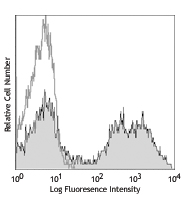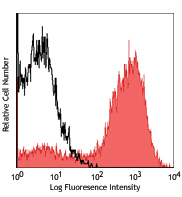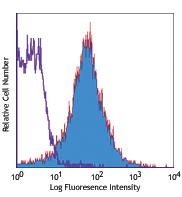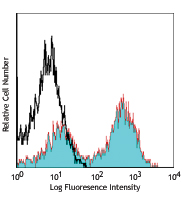- Clone
- 39-10-8 (See other available formats)
- Regulatory Status
- RUO
- Other Names
- MHC class II
- Isotype
- Mouse (C3H.SW) IgG3, κ
- Ave. Rating
- Submit a Review
- Product Citations
- publications

-

BALB/c mouse splenocytes stained with 39-10-8 FITC -

C57BL/6 mouse splenocytes stained with 39-10-8 FITC
| Cat # | Size | Price | Quantity Check Availability | Save | ||
|---|---|---|---|---|---|---|
| 115005 | 50 µg | 76€ | ||||
| 115006 | 500 µg | 210€ | ||||
The 39-10-8 antibody reacts with the I-Ad MHC class II alloantigen. These class II molecules are expressed on antigen presenting cells (including B cells) and a subset of T cells from H-2d bearing mice and are involved in antigen presentation to T cells expressing CD3/TCR and CD4 proteins. The 39-10-8 antibody does not cross-react with other haplotypes (a, b, k, p, q, s), but has been demonstrated to cross-react with the g7 haplotype.
Product DetailsProduct Details
- Verified Reactivity
- Mouse
- Antibody Type
- Monoclonal
- Host Species
- Mouse
- Immunogen
- (C3H x BALB/c)F1 mouse cells
- Formulation
- Phosphate-buffered solution, pH 7.2, containing 0.09% sodium azide.
- Preparation
- The antibody was purified by affinity chromatography, and conjugated with FITC under optimal conditions.
- Concentration
- 0.5 mg/ml
- Storage & Handling
- The antibody solution should be stored undiluted between 2°C and 8°C, and protected from prolonged exposure to light. Do not freeze.
- Application
-
FC - Quality tested
- Recommended Usage
-
Each lot of this antibody is quality control tested by immunofluorescent staining with flow cytometric analysis. For flow cytometric staining, the suggested use of this reagent is ≤1.0 µg per million cells in 100 µl volume. It is recommended that the reagent be titrated for optimal performance for each application.
- Excitation Laser
-
Blue Laser (488 nm)
- Application Notes
-
Additional reported applications (for the relevant formats) include: immunofluorescence microscopy2, and immunohistochemical staining of acetone-fixed frozen sections.
Does not cross-react with other haplotypes (e.g., a, b, k, p, q, s). - Application References
-
- Hiramine C, et al. 1995. Cell. Immunol. 160:157.
- Wang Z, et al. 2004. J. Immunol. 172:5924.
- Ma XT, et al. 2006. Cancer Research 66:1169.
- Norian LA and Allen PM. 2004. J. Immunol. 173:835. PubMed
- Tian C, et al. 2007. J. Immunol. 179:6762.
- Product Citations
-
- RRID
-
AB_313620 (BioLegend Cat. No. 115005)
AB_313620 (BioLegend Cat. No. 115006)
Antigen Details
- Structure
- MHC class II
- Distribution
-
B cell and activated T cells, APCs of H-2d mice
- Function
- Antigen presentation
- Ligand/Receptor
- CD3/TCR, CD4
- Cell Type
- Antigen-presenting cells, B cells, T cells, Tregs
- Biology Area
- Immunology, Innate Immunity
- Molecular Family
- MHC Antigens
- Antigen References
-
1. Watts C. 1997. Ann. Rev. Immunol. 15:821.
2. Pamer E, et al. 1998. Ann. Rev. Immunol. 16:323.
3. Wall KA, et al. 1983. J. Immunol. 131:1056.
4. Ridgway WM, et al. 1998. J. Exp. Med. 188:2267. - Gene ID
- 14961 View all products for this Gene ID
- UniProt
- View information about I-Ad on UniProt.org
Related FAQs
Other Formats
View All I-Ad Reagents Request Custom Conjugation| Description | Clone | Applications |
|---|---|---|
| Purified anti-mouse I-Ad | 39-10-8 | FC,IHC-F |
| Biotin anti-mouse I-Ad | 39-10-8 | FC |
| FITC anti-mouse I-Ad | 39-10-8 | FC |
| Alexa Fluor® 488 anti-mouse I-Ad | 39-10-8 | FC |
| Alexa Fluor® 647 anti-mouse I-Ad | 39-10-8 | FC |
Customers Also Purchased



Compare Data Across All Formats
This data display is provided for general comparisons between formats.
Your actual data may vary due to variations in samples, target cells, instruments and their settings, staining conditions, and other factors.
If you need assistance with selecting the best format contact our expert technical support team.
-
Purified anti-mouse I-Ad

BALB/c mouse splenocytes were stained with purified anti-mou... -
Biotin anti-mouse I-Ad

BALB/c mouse splenocytes were stained with biotinylated anti... -
FITC anti-mouse I-Ad

C57BL/6 mouse splenocytes stained with 39-10-8 FITC 
BALB/c mouse splenocytes stained with 39-10-8 FITC -
Alexa Fluor® 488 anti-mouse I-Ad

Balb/c mouse splenocytes stained with 39-10-8 Alexa Fluor® 4... -
Alexa Fluor® 647 anti-mouse I-Ad

BALB/c mouse splenocytes stained with 39-10-8 Alexa Fluor® 6... 
C57BL/6 mouse splenocytes stained with 39-10-8 Alexa Fluor® ...

 Login / Register
Login / Register 













Follow Us